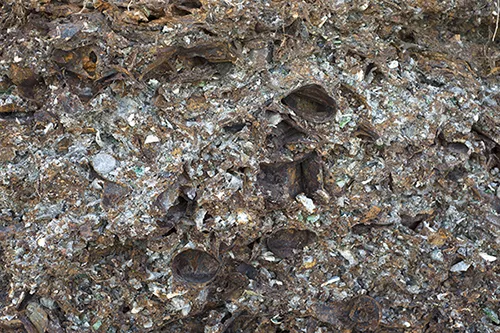
Curatorial studies program teaches art 'from the ground up'
“What’s the deal with the dirt pile?” ask the signs posted around the Mississauga campus. There, in the immaculate, polished concrete atrium of UTM’s Communication, Culture, and Technology Building, standing about hip-high, appeared a mound of chocolate-brown earth. Three cubic yards of it, seemingly overnight. Students cutting through CCT towards the library or maybe the RAWC studied the hill with puzzled faces. Some took pictures. It didn’t feel like a construction site or some landscaping project, so the question seemed important, urgent even: What’s the deal with the dirt pile?
From the ground up is one of three artworks installed around the University of Toronto Mississauga campus as part of the show Ground/works, the first-ever student-curated exhibition to come from a curatorial studies class at UTM. It’s the culmination of a semester-long pilot course called “Curating Now: Turning Concepts into Curatorial Projects”, part of the new Curatorial Studies Certificate Program launching officially in the fall.
“Historically, our courses have focused more on history and theory than practice,” says Professor Alison Syme, chair of the Department of Visual Studies. Ground/works, on the other hand, is representative of what students will learn while completing the new certificate. “It entails conceiving, planning and executing an exhibition from scratch,” she says, “coming up with an idea, researching and meeting with artists, budgeting, space planning, getting permissions, filling out loan agreements, installing and promoting the exhibition.”
Blackwood Gallery director/curator Christine Shaw, who taught the pilot, designed the course to provide students with practice-based, experiential learning opportunities. Mentored by Shaw and the Blackwood Gallery team, the inaugural class of seven (working under the moniker curators7) were issued their mission: to collaboratively produce an exhibition in just three months on a budget of roughly $5,000.

After drafting a long and impressive wish list of Canadian and international talents, the group selected and negotiated for works by Guelph-based artist Lisa Hirmer and the Sobey Award-winning duo Young & Giroux. Hirmer’s Leslie Street Spit Geologies — a photographic documentation of the east end Toronto landfill site — is installed as a billboard on the exterior of the William G. Davis Building (one of the oldest buildings on campus, Kim says, made from the same kinds of materials you’d find at the Spit). Young & Giroux’s three-channel film Infrastructure Canada, which leads a nation-wide tour of Canada’s various infrastructural systems, will be screened May 11, for one day only, inside CCT’s parking garage — itself an element of infrastructure.
The final installation is the dirt pile, an intervention contributed by the curators7 themselves. It’s a way for students to declare their autonomy, Kim says. “We want people to think about where they are,” she explains, “and what control they have over these spaces.”
The student-curator who served as Ground/work’s installation coordinator, who goes by the name “B.A.S.C.” and was responsible for installing From the ground up, says the practical experience taught by the course was invaluable. He describes a type of problem-solving that’s only learned in execution. Sure, it was difficult to arrange for something like a dirt pile to be located smack dab in CCT’s pristine halls, he says, but it was also terribly satisfying. “Sometimes, if you want to make a point, you have to get dirty.”
